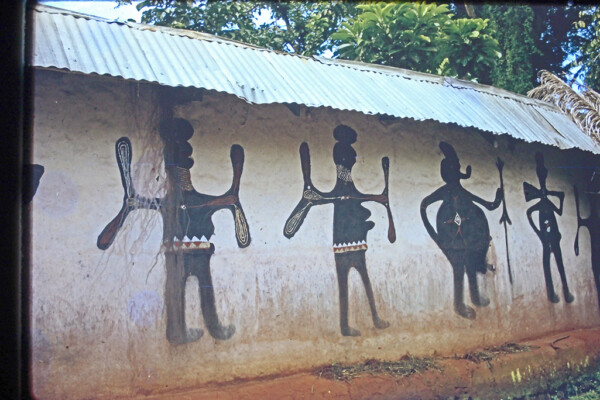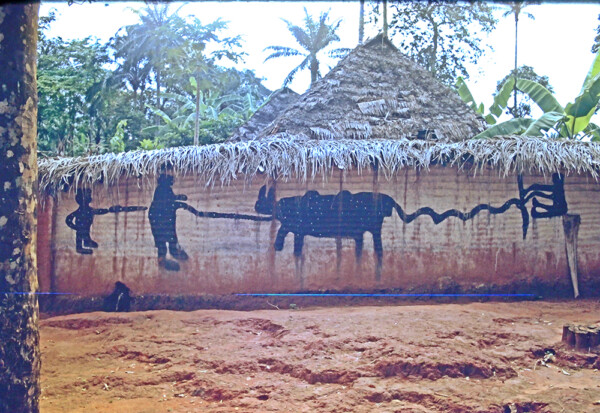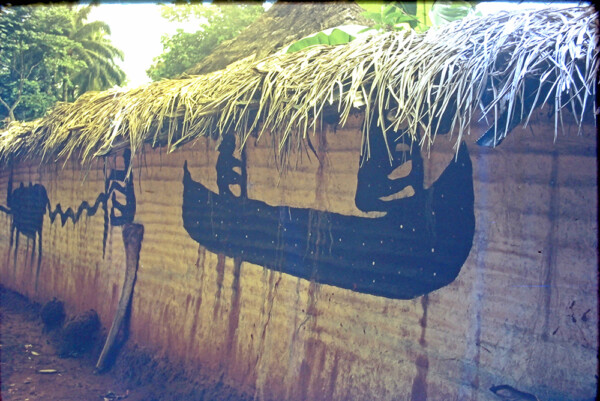Our friend Byron Maduegbuna was a man of very quiet ways, who nonetheless conducted us into a fine array of novel adventures. In a very early one, he took Helen and me to the Riverain town of Aguleri to see its annual Emergence Festival. (See that link elsewhere. in this Chapter.)
Aguleri is well-etched in the history of Roman Catholic Nigeria as the place where the legendary priest Father Flanagan saved the people from cannibalism, and after we observed the King’s Emergence, Byron introduced us to Father Patrick, who escorted us around the Church holdings, including the local “Witches’ Village” where the Church provided refuge for women so accused, located atop a nearby hill.
A charming man, he later served us some delicious drinks of Anisette in the Parish. When I admired the bottle (the likes of which I had not previously seen), he said it was but one item in a large stock of smuggled liquors kept in the Parish store, and told us that all we had to do to acquire such liquors in quantity was to go to the town of Nnobi (near Nnewi), to a certain compound there, where all we should have to do was tell the occupants that Father Patrick had sent us. Byron very much enjoyed good liquor, and when I suggested we try it out it he offered to escort me there.
So off the two of us drove one sunny day, eventually entering a forest-garden road onto which faced massive mud walls boasting several of the finest polychrome-painted carved wooden doors I had ever seen.
We stopped in front of a bamboo-walled palmwine bar near the marketplace, where I let Byron off to make our initial contact,, and I then drove off to look at some more of the carved doors.
You may imagine my astonishment when I drove past the large walled compound displayed at the top of this page . Behind the walls on the left you can see thatched-roof houses, while in the foreground a large field-garden has been prepared for planting ( not sure what crop was intended). .
Almost falling over at this sight, I got out of the car and started photographing.

The painted walls clearly depicted mythical scenes of sme kind, as you can see by the ppair of apparently winged (and tooth-stomached) creatures at left. To their right, another odd personage stands holding a staff depicting some kind of power (and the figure at right shoulders a rifle).

Another view appears to show men struggling with technologies involving ropes as they try to contain what appears to be a rhinocerus or some similarly dangerous beast. This location was but one of my photographic feasts.
Eventually, on one of my return-swings driving past the palmwine location, Byron emerged from the compound, looking very serious, and leaned through the open window of my tiny Fiat car to tell me he feared he was about to be eaten. “They are notorious cannibals,” he said, adding that when he had entered the compound and told the residents that Father Patrick from Aguleri had sent us, several men seized him and talked about killing him quickly.
Pleading for his life, Byron learned that only the previous week, agents of the Nigerian C.I.D. (Criminal Investigation Division) had raided the place and shaken the smugglers down for a considerable sum of money, and the smugglers saw us as a second wave of aggressors. To convince them of our innocence, Byron said he was merely accompanying “Father Dick”, a Roman Catholic Priest new to Nigeria, who would vouch for our innocence. “You are Father Dick,” he said, “and here they come.”
As a man, roughly my age and wearing dirty shorts and singlet, leaned on the sill of the passenger window, gazing at me with blank suspicion, I cast my brain for Irish speech, and the image of the 1940s Movie Star Barry Fitzgerald came to hand. “Sure and Begorrah” I said, I was Father Dick, new to Nigeria from the “Ould Sod”, and searching only “for a dram o’ the Wee Comfort”.

I have no idea where the words came from, Scottish or Irish, but I smiled broadly, and the man soon concluded we were harmless. 1
After we paid them off well (“not much of a bargain!” I thought),they brought out a small box which included a couple bottles of Anisette and several more of Portuguese brandy, and we drove away at a moderate pace, heading back to Onitsha.
Byron ostentatiously wiped his brow and voiced how close he had come to being chopped up for a stew 2 .
The Anisette later proved excellent, but the brandy bottles were capped with cork and the liquor had been heavily adulterated, presumably with local well water.
- My Fiat 600 no doubt helped: no self-respecting Nigerian government official would be sen driving a flimsy vehicle of this ilk. [↩]
- Reader take note! Byron tended to have, and to privately express in a grievous manner, extreme views of those he considered “others”. I did not take such comments seriously [↩]
